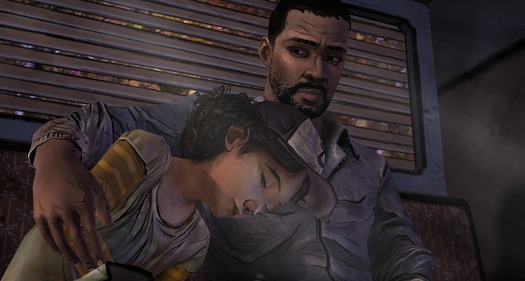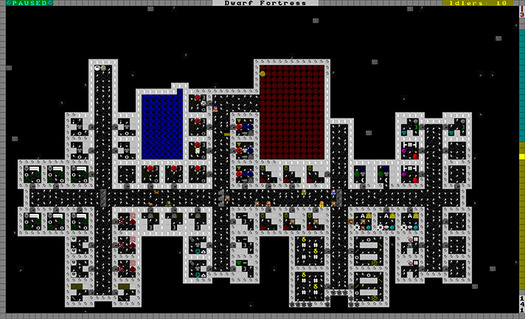
The Walking Dead screenshot from 8-Bit Girl
Dwarf Fortress, The Walking Dead, Mass Effect, Assassin’s Creed II, it was all geek to me but that was before I attended Kill Screen’s Two5Six conference on video gaming. The intention of the gathering was to explore what gaming can teach culture and what culture can teach games. My intention, as someone who cares about visual culture, but who knows nothing about gaming, was to see what I could divine from this emerging form. And the answer, at least to this Luddite, is quite a lot.
The room was packed with young men (just a scattering of women) in requisite sneakers, checked shirts, facial hair, and heavy framed glasses, their faces bathed in the cool moonlight underglow of their smart phones.
Running through the panel discussions such as “Feeling with Data” and “Space and Presence” was the unspoken theme of how video games are transforming the ways in which we tell and interact with storytelling. This was played out in various ways.
Kevin Bruner of Telltale Games, and creator (I’m not sure if that’s the correct word, “author”? “producer” — this stuff is so new, at least to me, it doesn’t yet have nomenclature), of the wildly popular The Walking Dead (28 million episodes and counting) revealed a fascinating element of the narrative construction of his game.
At one point in the game, the story branches in different directions according to how the player answers a series of questions. Those questions are not based on “action” — ie if I turn left, this happens, if I shoot now this will happen — but on emotional dilemmas posed within the game and having to do with the protection of a character named Clementine. These are questions of responsibility and consequence. How the player answers the question alters the course of the story (if I’m wrong about that, please leave a comment below).
In microcosm this represented to me a shift in how we construct, and experience, story, a shift that has significance for makers across a range of disciplines: designers, writers, film-makers, and curators. And that shift is that gaming is leading the way towards altering a linear story experience (as in a book, or a movie) towards something that is more immersive and engaged, where the player makes choices that has consequence and alters the narrative outcome.
These are baby steps. The player in The Walking Dead won’t experience an absolutely free and original outcome because each of the potential storylines has to be written, coded and rendered. But by enabling a choice based on a real-life emotional decision the game is a narrative game-changer, moving the viewer/reader away from being a passive spectator towards being an engaged participant.

Dwarf Fortress screen shot. Image via Techworld.
Another variation of this conceptual shift is embodied in the eccentric, hilarious and obsessive world of the Adam’s Bother’s Dwarf Fortress which, I was assured by the guy seated next to me, is the most admired game by game designers (Sim City, he said, is a mainstream rip-off). I’ll leave the explanation of this ferociously complicated game to the Museum of Modern Art’s catalogue description (it is now part of the permanent collection, acquired by Paola Antonelli for her 2011 exhibition “Talk to Me”).
The Adams brothers, with matching couch potato bellies and shorn hair, at first seemed like naïve innocents as they blinked in the glare of the stage lights, but Tarn Adams proved to be ironic, self-assured, funny and extremely smart.
He described Dwarf Fortress as an open ended game, with a “no win condition.” Each game is a self-generated world, always different, created by a combination of the choices made by the gamer and the coded characteristics of the games’ elements. Once the world is established, there is no way to predict what will happen. The game takes on it own life, surprising even Adams.
He riffed on the way the dwarfs, for no apparent reason, except a variation thrown up by code, value socks. They risk death to leave the fortress and remove the socks off a fellow slain dwarf. Or how Adams coded the carps but was shocked when one carp bit the arm off a dwarf and carried it around in his mouth for three (game) years.
In other words, as the player makes essential decisions about the material world of the game — rainfall, ore composition of the soil, geographical typology — Dwarf Fortress then open-endedly constructs it’s own world, extemporaneously responding to the chosen specifics, and never repeats itself.
I understood this to be analogous to a novelist who, given a pre-ordained set of characters, must decide on the compositional elements of time and place. These elements then interrelate partly by their own volition, and partly by authorial decisions. These elements interact not as an imposed plot but more like a self-generating interactive journey.
Dwarf Fortress is aesthetically crude (in a knowingly retro way) but fiendishly complicated and extensively researched. Adams described the work he put into constructing the characteristics of the inhabitants that exist under a simple graphic text (a “g” could signify a gibbon — white faced or black — or a groundhog or a Goblin — depending on the context and surrounding information). In order to realistically model the cloud formations he had to undertake what sounded like a self-taught PhD in meteorology.
Problem solving in this graphic environment pulls the gamer into the fictional world of Dwarf Fortress. The reciprocity between the gamer/author and the self-organizing improvisation of the game is engaging in a way that a linear text or film is not. Again, participation is key.
Jake Barton, of Local Projects, who is one of the designers of the recently opened 9/11 Memorial, spoke at the conference about how his work is also shaking up linear storytelling. The memorial seeks to drive viewers away from a conventional, explanatory museum experience towards a design that allows people to “self select” between artifacts. He called this “spacial storytelling” and it relies on his belief that “humans are narrative story-telling machines”.
He favors primary source material — i.e. artifacts, first-hand testimonials, and digital recording booths, where visitors can leave their own impressions and memories — as the essence of museum “interactive” design. Shared participation is crucial: more than a passive experience this is a museum design that encourages you to directly encounter the material in a physical and emotional way.
Alexis Ohanian, the co-founder of Reddit, ended the conference with a deceptively relaxed discussion with Jamin Warren, who had moderated the days’ proceedings with aplomb. Ohanian paid tribute to the “open-ended and responsive storytelling” theme that had run throughout the day, and draped his advocation of gaming in the evocation of his childhood, when he “was in love with my keyboard and mouse”. He recalled spending hours afterschool playing Golden Eye, a classic game of its era that revolutionized gaming with its split screen four shooter capability that allowed you to compete with other players from your at-home console: geek nirvana.
The technological enthusiasm of the conference was winning but it could have been off-set by at least one informed skeptic. And the old bug bear of video games, the almost across the board violence, was not addressed at all, perhaps purposefully. Experiencing countless digital deaths did seem to have anesthetized the audience. When Aleissa Laidacker mentioned that the rock climber that a character in Assassin’s Creed II was partly modeled on (there was an extraordinary video clip of him climbing a rock face) had, in the real world, died, there was no follow-up or explanation. It unintentionally came across as more of a technical inconvenience than as a human loss.
Ohanian made the point that the gaming medium is still in its infancy; it doesn’t yet have the traditions and skills of painting or film. But as the conference made clear, gaming is starting to transform the way we understand and use narrative as much as film editing, at the turn of the century, altered the way we perceive and understand space and time.
Along with the engaged and open-ended innovations in story design, gaming also raises questions about identity. Ohanian’s nostalgic description of his childhood cloaked a more serious argument about the ability of games to encourage and foster multi-dimensional identities, ie he didn’t find it weird to experience falling in love in the digital realm or taking seriously playing the lute at a digital wedding. He found liberation in what others might call social hibernation, and he was convincing. “We are not mirrors anymore” Warren quoted from last years’ conference, “we are diamonds”.

